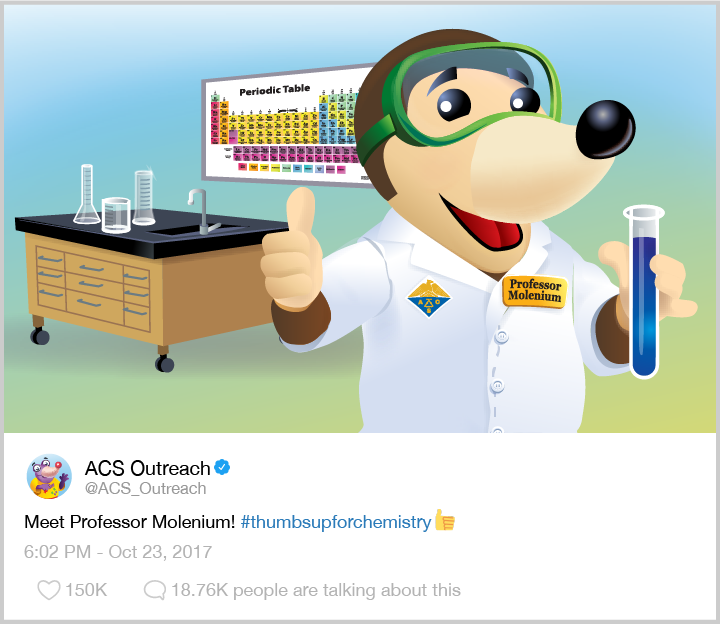Meet the Moles!
Introducing our newest mole, Dr. Erla Meyer!

Name: Erla Meyer, Ph.D
Occupation: Chief Technology Officer, Phoenix Enterprises
Bio: Dr. Meyer is a trained chemist whose career path took her out of the lab and into corporate HQ. After grad school, Erla wanted to explore her options beyond academia, and found herself interning in the materials division at Phoenix Enterprises. Two decades later, she leads a team of fifty researchers and is responsible for the strategy behind all kinds of important science. Erla loves the challenge of fostering innovation, mentoring young scientists and seeing the direct impact her work has on people’s everyday lives.
Hobbies: Outside the office, you can find Erla playing around with “Mole”-ecular gastronomy, long-distance cycling or practicing her calligraphy skills.
Learn more about ACS moles below.

Hey everyone! My name is Avogadro, but all my friends call me Avi. You may have seen my adventures with my friends in Celebrating Chemistry.
When we are not exploring, we go to Mole Hill Elementary School. I like going to school because that’s where my teacher, Professor Molenium, teaches us chemistry!
He recently taught us what a mole is. I used to think a mole was just an animal like me, but I learned it’s also a way chemists measure things that are so small we can’t even see. A mole of something means you have 602,214,076,000,000,000,000,000 of that thing! Because this is a very big number, scientists shorten it to 6.02 x 1023. Professor Molenium also told us this number is named after the scientist, Amedeo Avogadro, and it’s called Avogadro’s number – like me! How cool is that?!

You may be wondering how chemists came up with a number like 6.02 x 1023 but there is a reason! Chemists defined a mole as the amount of atoms that are in exactly 12 grams of carbon-12, which is Avogadro’s number!
Don’t worry – I was confused about this at first too but, trust me, it gets easier! You have probably used a word like “mole” before and didn’t even know it. It’s like using the word “pair” to describe having two socks, or using the word “dozen” to describe having twelve eggs. If you had a “mole” of eggs, then that means you have 602,214,076,000,000,000,000,000 eggs! Think of all the omelets you could make!
Chemists don’t measure eggs in moles, though. They measure things that are really, really small like atoms, molecules, and other particles. Atoms are the building blocks of matter, and atoms can be connected to make molecules. Because atoms, molecules, and other particles are all extremely small, you need a lot to even weigh them, so that’s why chemists use the word “mole.”
Keep in mind that not everything weighs the same if you have a mole of it. A mole refers to the number of particles you have, not the mass. If you had a mole of feathers and a mole of bricks, you would have the same number of feathers and bricks but they would weigh completely different.
Here are the main points that Professor Molenium taught us at school:
- A mole is a very important unit of measurement that chemists use.
- A mole of something means you have 602,214,076,000,000,000,000,000 of that thing, like how having a dozen eggs means you have twelve eggs.
- Chemists have to measure using moles for very small things like atoms, molecules, or other particles.
- 602,214,076,000,000,000,000,000 is called Avogadro’s Number and is shortened to 6.02 x 1023.
But that's not all! When I’m at school, I do more than just learn – I also get to see all of my friends! One of my good friends is Meg A. Mole. She is really lucky because she travels to meet different chemists. She’s interviewed a forensic anthropologist, a paint manufacturer, a soil scientist, an environmental process engineer, and more! She has even interviewed an astrophysicist!

Without her, I never would have known that there were so many unique careers that involve chemistry. Make sure to check out all of her interviews so you too can see the diversity!
Now that you’ve learned about moles, you’re on your way to becoming a chemist! Every good chemist knows when to celebrate the importance of chemistry. Join chemists for community events and contests during these celebrations:
Contact your local ACS Outreach Coordinator (NCW Coordinator Lookup or CCEW Coordinator Lookup) or find an event (ACS Event Locator) in your area to celebrate with chemists around the world!



